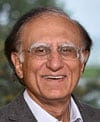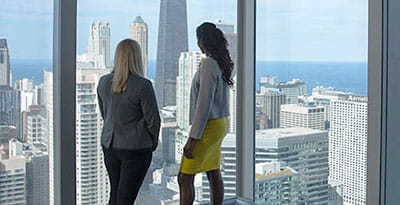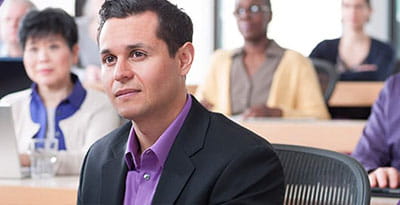
Thought Leadership
Planning High-Energy Meetings: The Cure for Zoom Fatigue
Dull, ineffective meetings were already a problem in the in-person era. Now, with COVID-19 forcing a shift from room to Zoom, they’re a virtual issue, too.
However, that needn't be the case, according to Sanjay Khosla, Senior Fellow and Adjunct Professor of Marketing and co-Academic Director of Kellogg Executive Education’s Delivering Business Growth program. With the right approach, Zoom discussions can be high-energy and engaging. And that approach begins with a plan.
“I recently attended a Zoom meeting of a not-for-profit that started with the CEO saying he was so giddy with excitement that he couldn’t sit down,” Khosla recalled. “He set the tone of infectious energy so beautifully, and it was much more effective than simply thanking everyone for being there. It was effective because that’s not how people normally start a meeting, and it was authentic.”
The key to the meeting’s success, Khosla said, was that all information was shared beforehand rather than being presented in the meeting itself. Everything was sent to attendees ahead of time. “We went straight into, ‘So what? Now what?’ and ended with ‘Who does what by when?’ ” said Khosla. “So it was a very simple structure for creating engagement and high energy.”
A useful element for adding interest to meetings is that of surprise. A tactic Khosla has used to good effect is to tell an attendee in chat or via text that he’s going to call on them in a few minutes to highlight something exciting they’ve accomplished. “The idea is to provoke and spotlight — but always in a positive fashion,” he said. “It’s a celebration of success, and it’s very effective, but the focus is not to have them say, ‘I did this’ or ‘I did that.’ You have them discuss what they learned from their success and how they scaled it. All interactions should be high-energy and can-do.”
On the flip-side, one can maintain interest and impact by highlighting something that didn’t work, but the focus should be on lessons coming out of it. “You don’t shame people,” Khosla noted. “You ask them to identify one professional failure from the last year and discuss what they learned from it. You introduce some humor. It’s hard to connect at an emotional level on a computer, but this makes people vulnerable and humble. You focus on what happened, who’ll do what by when and next steps so that it’s action-oriented.”
There are some natural pitfalls accompanying high-energy meetings, but they can be dealt with by outlining a few requirements for participants. One is to put strict time limits on how much a given team or individual participant can speak so that no one party dominates the discussion. Another is requiring every member of a team to contribute when it’s that team’s turn. “If it’s a three-person team, all three have to say something,” Khosla said. “They have to build off of one another, and none of them may speak for more than, say, three minutes. When time’s up, you have a third party cut them off. You can do it in a fun way.”
Meeting organizers can help avoid low-energy events with some simple ground rules as well. It’s a good idea, for example, to tell attendees that no one may switch their video off and that everyone has to add to the conversation, assuming it’s not too large a gathering for that to be practical. “You push the quiet people to participate,” Khosla said. “With the proper rules of engagement set up, people get into the rhythm, and it works.”
Overall, according to Khosla, a good mix of creativity and sensible rules greatly increases the odds of a fruitful meeting for all. But all of those elements must have a purpose in mind. “We've found techniques such as, ‘Show us your cat’ or, ‘Let's have a wine party’ are fine,” he said. “But you need to include the meatier discussions as well. Have people and teams talk about themselves and their successes. That makes for a meeting that’s substantive and structured and moves the agenda of business along.”
It’s also important to remember that there’s no such thing as a perfect meeting or workshop, Khosla added. That's why it's important to ask participants for feedback on what worked and what didn’t. “There is always a better way,” he said. “Keep learning — and keep doing better.”
 |
Sanjay Khosla is a Senior Fellow at Northwestern University's Kellogg School of Management and a Senior Advisor at Boston Consulting Group. He teaches in a variety of Kellogg Executive Education programs, including Delivering Business Growth and Kellogg on Branding. He is the co-author of Fewer, Bigger, Bolder with his colleague Mohan Sawhney. |
Download a Brochure >
Spaces are limited. Register today.
Delivering Business Growth
Emphasizing action, this program teaches a market-tested framework that has delivered sustained double-digit growth in revenues and margins for major global brands. You’ll leave with a business growth strategy and actionable agenda for driving growth within your organization.
Upcoming Sessions
|
June 15-18, 2026 Start: June 15 at 1:00 PM End: June 18 at 11:45 AM
A preferred hotel rate is available at the Omni Chicago. |
$9,950 Fee does not include accommodations. |
|
|
October 26-29, 2026 Start: October 26 at 1:00 PM End: October 29 at 11:45 AM
|
$9,950 Fee does not include accommodations. |



